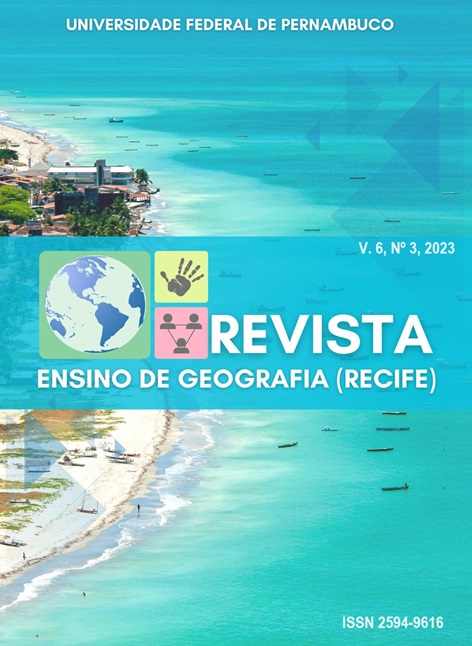School geography: the use of tactile teaching materials for education and guidance of people with visual impairment
DOI:
https://doi.org/10.51359/2594-9616.2023.261028Keywords:
visual impairment, school geography, tactile materials, inclusive practicesAbstract
Geography contributes to the understanding of spaces, being essential for the individual's citizenship formation. Recognizing this importance, it is necessary to consider the aspects that permeate the educational sphere, an approach that originates the investigation of this article, which seeks to understand how inclusive practices from the perspective of School Geography, based on didactic-pedagogical resources, can facilitate the process of teaching and learning for students with visual impairments or low vision, with emphasis on the production and manipulation of tactile teaching materials. To achieve this, a bibliographical survey of authors who discuss school geography, inclusion and teaching practices became essential. In addition, documentary research was used on documents that are part of Brazilian educational legislation, such as the National Common Curricular Base (BNCC). The present investigation is part of the results of the productions developed in the Geography Teaching curricular component in the pedagogy course of a Higher Education institution in Rio Grande do Norte, at which time the undergraduates produced tactile materials based on themes related to population studies . From the readings, document analysis and production of the material, we consider the tactile teaching resource as a creative and didactic tool, which enables the students' learning process.
References
BRASIL. Ministério da Educação. Base Nacional Comum Curricular. Brasília, 2018.
CARNEIRO, R. U. C. Educação inclusiva na educação infantil. Práxis Educacional, v. 8, n. 12, p. 81-95, 2012. Disponível em: http://hdl.handle.net/11449/124965. Acesso em: 01 de Junho de 2023.
CUSTÓDIO, G. A; NOGUEIRA, R. E. O APORTE DA CARTOGRAFIA TÁTIL NO ENSINO DE CONCEITOS CARTOGRÁFICOS PARA ALUNOS COM DEFICIÊNCIA VISUAL. Revista Brasileira de Cartografia, Rio de Janeiro, N° 63/4, p. 757-772, Jul/Ago/2014
DECLARAÇÃO DE SALAMANCA. Sobre Princípios, Políticas e Práticas na Área das Necessidades Educativas Especiais. Espanha, 1994. Disponível em: http:// portal.ec.gov.br/seesp/arquivos/pdf/alamanca.pdf . Acesso em: 01 de junho de 2023.
FERREIRA, A. A.; RODRIGUES, S. X. C.; JESUS, J. N. de. A importância da prática de ensino em Geografia. In: EDIPE – ENCONTRO ESTADUAL DE DIDÁTICA E PRÁTICA DE ENSINO, Anais ..., v. 4., Quirinópolis - GO, 2011
MANTOAN, M. T. E. Inclusão escolar- O que é? Por quê? Como fazer?. São Paulo: Editora Moderna, 2003.
MANTOAN, M. T. E. Ensino inclusivo: educação de qualidade para todos. Brasília: Revista Integração. SEESP, ano 8, nº 20, 1998.
MASINI, E. F. S. A pessoa com deficiência visual: um livro para educadores. São Paulo: Vetor, 2007.
MOREIRA, A. F. B.; CANDAU, V. M. Currículo, conhecimento e cultura. Indagações sobre o currículo. In: BEAUCHAMP, J.; PAGEL, S. D.; NASCIMENTO, A. R. (Orgs.). Brasília: Ministério da Educação, Secretaria de Educação Básica, 2008. p.17-48.
SOUZA, S. E. O uso de recursos didáticos no ensino escolar. In: I Encontro de Pesquisa em Educação, IV Jornada de Prática de Ensino, XIII Semana De Pedagogia da UEM: “Infância e Práticas Educativas”, Anais... Maringá: UEM, 2007.
Downloads
Published
How to Cite
Issue
Section
License
Copyright (c) 2024 Monica Leticia de Medeiros, Samara dos Santos de Araújo, Djanni Martinho dos Santos Sobrinho

This work is licensed under a Creative Commons Attribution 4.0 International License.
Authors who publish with this journal agree to the following terms:- Authors retain copyright and grant the REVISTA ENSINO DE GEOGRAFIA (RECIFE) right of first publication with the work simultaneously licensed under a Creative Commons Attribution NonCommercial International 4.0 (CC BY-NC) that allows others to share the work with an acknowledgement of the work's authorship and initial publication in this journal.
- Authors are able to enter into separate, additional contractual arrangements for the non-exclusive distribution of the journal's published version of the work (e.g., post it to an institutional repository or publish it in a book), with an acknowledgement of its initial publication in this journal.
- Authors are permitted and encouraged to post their work online (e.g., in institutional repositories or on their website) prior to and during the submission process, as it can lead to productive exchanges, as well as earlier and greater citation of published work.



